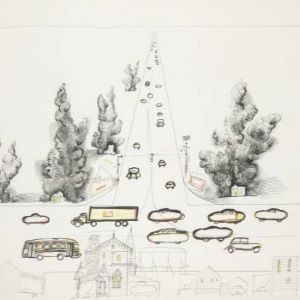Saul Steinberg (1914–1999), an American artist with Romanian roots, was a man with a broad cultural and political outlook that is also reflected in his work, which deals with everyday human life with all its paradoxes. Steinberg’s drawings, masks, collages, and assemblages are known for their penetrating analysis of modern society. A stay in Milan, where he studied architecture and made his cartoon debut in the humour newspaper Bertoldo, was a pivotal time for Steinberg. Even then, he impressed with his ability to express a complex idea with an original point through playful yet witty visual shortcuts. Steinberg was a true example of homo ludens in Schiller’s sense. Through play, he developed his thinking and explored different levels of meaning, which he then elaborated on in different contexts.
He was forced to emigrate from Italy after the rise of the fascist regime. This experience is also reflected in his work through a feeling of a particular psychological uprootedness and an unceasing need to find his place on the geographical map of the world. He found asylum in the United States, and New York became his home and inspirational artistic base.
Steinberg is best known for his work for popular magazines such as The New Yorker. His later works are more philosophical, and their conception is more abstract. He expressed his feelings about life in language the audience could understand but never abandoned the deeper connections. Steinberg referred to himself as “a writer who draws”. With simple lines, he recorded his specific view of the world around him, seen through the eyes of a careful observer, noting the stereotypes and absurdities of human action. This view is apparent in the ten drawings from the National Gallery Prague’s Collection of Prints and Drawings, from a generous gift from The Saul Steinberg Foundation, New York.
Collection of Prints and Drawings
Curator: Adriana Šmejkalová
Expert collaboration and coordination: Anna Strnadlová



